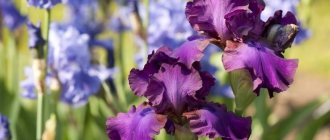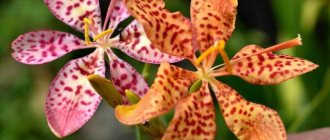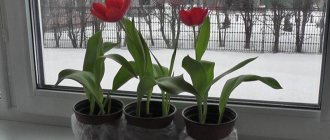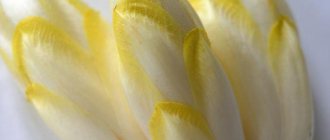Perennial coreopsis: varieties and varieties
Of the more than 100 varieties of coreopsis, no more than 30 are grown in culture.
Coreopsis is a shrub consisting of erect branched stems crowned with inflorescences of yellow, yellow-brown, as well as red and pink flowers of a pinnately dissected or palmately divided form. The most common varieties of perennial coreopsis:
- Lanceolate. A bush up to 60 cm high with yellow inflorescences up to 6 cm in diameter. It blooms for two months starting in July.
Coreopsis lanceolate
- Whorled. A shrub up to 60 cm high that blooms all summer. It is distinguished by light green thin foliage.
Coreopsis Whorled
- Pink. Low (up to 40 cm) shrub with red inflorescences.
Coreopsis Pink
- Grandiflora. This type of coreopsis is distinguished by bushes topped with large flowers of a dark golden or lemon color. The powerful bush can reach up to 1 m in height and blooms for two months from the very beginning of summer.
Coreopsis Grandiflora
Planting coreopsis in open ground
When to plant
Perennial coreopsis is planted in open ground in the middle or at the end of May, when warm weather sets in, the ground warms up and the threat of return frosts passes. However, the seedlings must first undergo hardening procedures for two weeks: the seedlings are taken out into the open air every day, gradually increasing the duration of the walk.
How to plant
The coreopsis plant prefers sunny areas, and only some species (whorled and pink coreopsis) can grow in partial shade. The plant needs moderately moist, light, loose, neutral and well-drained soil. As for fertility, some types of coreopsis will not benefit from a high content of nutrients in the soil: this makes them bloom poorly. Before planting, poor soil can be slightly enriched by digging with compost or humus.
In the photo: How coreopsis blooms
Coreopsis seedlings are planted in holes located at a distance of 30 cm from each other. After planting, the surface of the area is compacted and watered.
- Vechernitsa: cultivation, care, types and varieties
Planting a plant
It is better to choose a sunny place for planting coreopsis, because in the shade and partial shade this plant does not feel comfortable and may wither. Moderately fertile light soils are well suited for this flower.
Advice. For coreopsis to bloom lushly, the soil must be loose.
It is best to plant perennial coreopsis with seeds. In order for the plant to bloom in the first year of planting, you can sow seeds in winter for seedlings in pots or boxes indoors. And after the end of the frost, transfer and plant the grown seedlings in open ground. There are no special requirements for growing coreopsis seedlings. Just provide your plants with enough light and moisture, and sprouts will follow.
Coreopsis is very easy to grow from seeds.
Coreopsis seeds can be sown directly into open ground both in spring and autumn - the seeds of this plant tolerate low temperatures well. After the first shoots appear, it is necessary to thin them out and monitor them so that weeds do not interfere with the growth of flowers. And also ensure regular watering.
Growing coreopsis from seeds
Sowing seedlings
Planting and caring for coreopsis will not require much time or effort from you. Annual coreopsis can be sown in open ground in May, and in a greenhouse in mid-April. Perennial species usually form flowers in the second year after sowing, but if you want to see flowering in the current season, use the seedling method: grow perennial coreopsis seedlings on the windowsill, and then transplant them into the flower garden.
In the photo: Coreopsis in a flowerbed
Sowing of coreopsis for seedlings is carried out in early March: the seeds are evenly laid out on the surface of moist, nutritious garden soil placed in shallow containers, pressed against the ground with a board, covered with film and placed for germination in a warm, bright place.
- Wheatgrass: cultivation, properties and applications
Seedling care
The crops should be ventilated daily, removing condensation from the film. The germination rate of the seeds of this flower crop is very high. Coreopsis from seeds will begin to germinate within ten days, and as soon as this process becomes widespread, the coating from the container can be removed. Caring for seedlings involves watering and carefully loosening the substrate around the seedlings.
Use moderation with moisture, as seedlings may suffer from blackleg, a fungal infection that affects plants during the seedling period and develops in waterlogged soil.
At the stage of development of the seedlings' first pair of true leaves, they are picked out in separate cups. If picking is done in a box, keep a 2 cm step between seedlings and keep in mind that the seedlings will have to be picked again when the seedlings grow to 10-12 cm.
Coreopsis care
Coreopsis is an unpretentious flower. Its advantages include frost resistance and drought resistance. In the middle zone, this flower does not need to be covered for the winter. For abundant and long-lasting flowering, coreopsis needs timely watering. After the plants have flowered, it is necessary to prune them; to do this, cut off a quarter of the plant with garden shears. After pruning, the crop needs to be fed and its flowering will resume.
In summer, protect coreopsis from drying out, and in winter - from exposure to frost.
For the winter, many gardeners advise cutting off the stems at the root. If you live in regions where winters are very frosty, then it is better to cover your flowers with a small layer of foliage or spruce branches.
Advice. Remove faded flowers promptly. This stimulates the appearance of young buds.
The best varieties of coreopsis with photos and names
Coreopsis large-flowered terry early sunrise Coreopsis Early Sunrise photo
The Early Sunrise variety has a special charm: full, dense double flowers cover the bush with a yellow cloud. The bushes are low and compact.
Coreopsis dye Amulet amulet photo
The flowering of the Amulet variety resembles a blazing fire: bright scarlet flowers cover dense bushes like a continuous carpet. The variety is effective both in single plantings and in contrasting combinations with other flowers.
Coreopsis yellow moonbeam photo
The delicate yellow flowers of the moonbeam variety captivate with their delicate charm, truly reminiscent of the radiance of the moon or small stars scattered across a dark green carpet of leaves.
Coreopsis ruby frost Coreopsis ruby frost photo
Bright and showy: the Ruby Frost variety has deep red flowers with white edges around the petals. Flowering is abundant and continuous.
Coreopsis Sharman sharman photo
The Sharman variety is notable for its unusual combination of color and shape: on top of the wide scarlet petals there is a row of thin bright yellow petals, reminiscent of rare rays on a blazing crimson background.
Coreopsis grandiflora 'SunKiss' photo
The compact, powerful bush of the San Kiss variety is crowned with large, bright yellow flowers with orange centers. The edges of the petals are dissected, which gives a special lightness to the flowers, reminiscent of fluttering butterflies.
Plant propagation
There are several ways to increase the coreopsis population in your garden.
- Division. One of the simplest and most reliable methods of propagation is dividing the rhizome. It is best to divide in early spring, when the soil has already thawed. The soil around the plant must be loosened and the bush must be carefully dug out so as not to damage the rhizome. The root is divided with a sharp knife so that 2-3 buds remain on each division. The cuttings are planted and cared for like ordinary adult plants.
Coreopsis easily survives propagation by cuttings or dividing the bush
- In summer you can propagate coreopsis from cuttings . To do this, in June-July, healthy shoots with several leaves are cut 10 cm below the internode and placed in seedling pots. Leaves must be removed from the bottom of the cutting. You can place up to 3 cuttings in one pot. Pots should be kept in partial shade and watered regularly. In such conditions, cuttings take root very quickly.
Description of perennial plant species Coreopsis
Coreopsis (Coreopsis) perennial
You can find seeds of various types of coreopsis on sale. To buy a suitable variety for a flowerbed or garden, you need to have an idea of their characteristics.
Coreopsis whorled
Perennial 60-90 cm high and up to 60 cm wide. The rigid branched stem at the ends of the shoots has single large simple flowers 3-5 cm in diameter. The most famous varieties: Zagreb with lemon and Moonbeam with gray-yellow petals. Suitable for growing in containers.
Coreopsis Bengal Tiger
Coreopsis grandiflora
The grandiflorum species differs from others in that it reproduces primarily by vegetative means rather than by seeds. The plant height is on average 45-60 cm with a similar width. Leaves lanceolate or lanceolate-dissected. The predominant color of the flowers is yellow.
Coreopsis grandiflora
Lanceolate
A low-growing perennial, mostly only 10-30 cm high, but there are varieties that grow up to 60 cm. The leaf is lanceolate, petiolate, up to 12 cm long, green.
Inflorescences are 1.5-3 cm in diameter, predominantly golden-yellow in color. The peculiarity of the species is its very long flowering, sometimes from March-April until the end of summer.
Coreopsis lanceolata
Terry
This group of perennial low-growing varieties is distinguished by almost spherical flowers, in which the core is often not visible at all behind the long petals. The foliage can be lanceolate or lanceolate-dissected, colored green or dark olive.
Terry coreopsis
Variegated
In another way, such varieties are called variegated. The narrow lanceolate foliage is pale green with whitish-yellowish asymmetrical chaotic spots. In bright light, the leaves curl slightly from the edges inward. Flowers are formed on long thin stalks.
Variegated coreopsis variety Calypso
Hybrid
Thanks to the work of breeders, various colors of this plant have been developed. Thus, pure red, violet, and purple tones are not found in natural forms. But it is quite possible to buy seeds of such coreopsis if you want to grow some unusual variety.
Note! Hybrids reproduce only vegetatively, by dividing the rhizome.
Coreopsis Ruby Frost
Other
There are many very popular species of coreopsis that are not rare and are freely available for sale:
- ear-shaped (lat. Coreopsis auriculata) - its inflorescence is formed by flowers with long reed petals rolled into tubes;
- pink (lat. Coreopsis rosea) - the name speaks for itself, the flowers are painted in bright shades of pink or purple;
- coreopsis tinctoria (lat. Coreopsis tinctoria) - its seeds turn yellow when soaked in water;
- feruleleaf (lat. Coreopsis ferulifolia) - the marginal flowers of the inflorescence are reed flowers of an elongated oval shape, resembling simple (non-double) dahlias.
Coreopsis auricularis
Diseases and pests
Coreopsis has a fairly strong immune system and is rarely attacked by pests or diseases, however, there is no 100% guarantee. Known diseases include leaf rust and fusarium. In this case, it is enough to tear off the damaged leaves and you can spray the plant with fungicides. If these remedies do not help, then the bush should be completely removed to prevent infection of other plants in the flower garden.
More often than other diseases, coreopsis overcomes fusarium
The same must be done when viral infections are detected. If the plant is stunted in growth, its tops and flowers curl into a tube - feel free to remove the bush.
Among the pests, coreopsis can be affected by aphids and various beetles. Beetles must be removed by hand, while for aphids you can use specialized preparations or folk remedies.
Possible problems in growing
Under unfavorable weather conditions, the plant can become a victim of fungal infections, as well as invasion of insect pests.
Problems with leaves
The following alarming symptoms can be found on the bushes:
- dry dark spots on the lower foliage - indicate septoria coreopsidis;
- whitish stains are a sign of powdery mildew (Erysiphae cichoracearum);
- white spots on the underside of leaves - downy mildew (Plasmopara halstedii).
If such lesions are detected, spraying with an antifungal drug, for example, Fundazol, should be carried out.
Pests
Most often, the flower is affected by aphids and leaf flies. They are easy to spot on coreopsis; just look closely at the bush. Spraying with a weak soap solution or an appropriate insecticide helps against them.
For reference! For aphids, you can use Fitoverm, Aktar, Iskra-M and other drugs containing permethrin or aversectin.
Diseases
A common disease that affects coreopsis is rust. Its traces are easy to notice on the leaves, which become covered with red spots and then dry out. For prevention, before the buds open, the planting is sprayed with a 1% solution of Bordeaux mixture or another copper-containing preparation.
Signs of improper care
A typical mistake made by those who have not previously grown this plant is excessive feeding. Because of this, foliage grows quickly and abundantly, and flowers are reduced in number and reduced in size.
Note! With excessive flooding, the foliage begins to wither, starting from the tips, and turn yellow.
Caring for coreopsis is not at all difficult; many people believe that it is enough to just plant it, and then it will grow on its own. This is partly true, but still, truly large and beautiful flowers are obtained with regular feeding.
Coreopsis perennial in landscape design
Due to its long flowering period, coreopsis is in demand in landscape design. Flowerbeds in which roses, lilies and rudbeckias are added to coreopsis turn your garden into a fragrant paradise.
Low-growing shrubs are great for decorating borders, and they also look great in pots and containers hung outside windows and displayed on terraces.
Along with other perennial flowers, coreopsis is often placed along the perimeter of lawns, and small flower beds are also arranged between paths and sidewalks.
Coreopsis in landscape design
Varieties with tall stems create a colorful carpet for a group of annuals. In a flower garden, tall varieties are recommended to be moved to the background, and also used in group plantings.
Numerous design photos will help you determine the best place for coreopsis in your garden.
Coreopsis is a great flower for those who don't have enough time for more finicky plants. Not inferior to them in beauty and brightness, it will decorate your flower garden until the coldest weather, without requiring special attention.
Types and varieties
Coreopsis grandiflora - a short-lived perennial, often grown as an annual, has single yellow flower heads with a diameter of 6 cm. The plant has bright green leaves, forms a compact bush, height and width 75x60cm. Among the varieties of this species, the following forms stand out.
The best varieties of coreopsis with photos
| Variety name | Description of the variety | Photo |
| Airlie Sunrise |
(Early Sunrise)
A variety with double golden flower baskets.
Goldfinch
(Goldfinck)
A low variety, growing up to 25 cm, has single flower baskets of golden color.
Mayfield Giant A tall variety, grows to about 80 cm, has single baskets of bright yellow color.
Presto Dwarf variety, grows up to 15-30 cm.
Sun child (Coreopsis grandiflora Sonnenkind) The variety has one yellow basket of flowers, height up to 40 cm.
Sunbeam or Sunray One of the most beautiful varieties with dark yellow, semi-double baskets. Quite tall - up to 80 cm.
Golden ball Variety up to 50cm high, blooms with double flowers in July – September.
Golden Baby Low-growing variety - stem length 40 cm, double flowers appear in July, bloom until September.
Ruby frost (coreopsis ruby frost) Coreopsis Ruby frost is very decorative - with beautiful scarlet flowers with a white border and a yellow center.
Among coreopsis there are annual and perennial species:
- Annuals include: Drummond's and Dying's coreopsis.
- Perennials include: Whorled and Pink Coreopsis.
- Coreopsis Drummondii (Coreopsisdrummondii) is an annual plant, grows up to 50-70 cm, has feathery leaves. Flower baskets are yellow with a brown center. They bloom all summer, seeds are sown in open ground at the end of April, in regions with cold climates - in the second half of May. Seeds for seedlings are sown in pots in March.
- Coreopsis tinctoria - an annual plant with a two-color flower, grows up to 40 cm, forms dense bushes, the flowering period is towards the end of summer. Prefers sunny positions. It has small feathery leaves, very decorative yellow flowers with a wide purple-burgundy center. Includes low-growing varieties that can be grown in a pot on the balcony, and tall varieties that are ideal for perennial gardening. Suitable for cut flower.
- Coreopsis verticillata is a perennial plant, grows up to 50-70 cm, forms dense bushes. It has very narrow, needle-like, feathery leaves, yellow flowers with a diameter of 4-6 cm. It blooms in July-August. Requires sunny positions, use of supports. Interesting varieties:
- "Moonbin" with milky yellow reed flowers;
- Golden Shower - a profusely flowering variety with yellow flower baskets;
- Grandiflora (Grandiflora) - has golden-yellow baskets, a compact bush, flowers with a jagged edge and a light brown center with a diameter of 8 cm, stem height 80 cm;
- Limerock Ruby (Lemon Punch) – pale yellow petals with a pinkish, unevenly distributed, blurry blush;
- "Limerock Ruby" - red flowers, shoot height 40 cm;
- Coreopsis Rosea is a rather low perennial, growing up to 30 cm. It has thin, straight shoots, small, balanced leaves. Decorative flowers are pale pink, dark pink, sometimes white.
- Lanceolate (Coreopsis lanceolata) is a perennial that blooms in single, bright yellow baskets 6 cm in diameter and flowers cut off at the edges. The leaves are bright green, lanceolate, 15 cm long, forming a rosette. Height and width 55×40 cm. Varieties of this type:
- Baby Gold – golden flowers, height 20 cm;
- Sunburst is a variety with semi-double yellow baskets, 75 cm high.
Conclusion
Coreopsis perennial is an undemanding plant that grows naturally in prairies and sands. Therefore, coreopsis is easy to care for and grow, and rarely gets sick. The plant blooms with beautiful sunny yellow flowers of various shades. Decorative qualities, unpretentiousness and easy care make it a frequent guest in our gardens.
Coreopsis: photo
Varietal features
Possessing high winter hardiness, coreopsis grows as a perennial.
A medium-sized shrub with erect shoots and lanceolate light green leaves does not grow higher than 50 cm. It overwinters well even in the middle zone and grows quickly, forming new rosettes. Despite its unpretentiousness, the Golden Ball is distinguished by its gorgeous flowering. In mid-summer, fairly large single flowers bloom above the bush. Terry, they are painted bright yellow and really look like golden fluffy balls. You can admire such beauty for a long time, right up to the frost.
Application in design
Coreopsis is an elegant crop that blooms for a long time, producing a large number of attractive buds. Tall varieties are used to create especially abundant flower arrangements, they are planted in the far corner of the garden, and entire groups are created on lawns. In addition, such crops are good for cutting, since coreopsis flowers can last in a vase for two weeks.
Low-growing flowers are used for planting in front gardens in the form of a border or in groups. Such varieties can be planted in street flower beds, in containers or in balcony baskets at least twenty centimeters deep. It is allowed to replant such a plant even during its flowering period, but it is important to dig up the crop along with a lump of earth and plant it on well-watered soil.
The culture is often used to decorate individual flower beds, mixborders and for cutting. Annual dwarf varieties (Douglas, pink) are planted in pots, perennials - in open flower beds and soil on the site.











